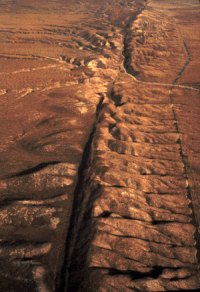An aerial view of the San Andreas fault in the Carrizo Plain, Central California. Image: USGS, Wikimedia Commons.
(PhysOrg.com) -- In the past, seismologists have had to rely on information provided by just a few sensors in the vicinity of an earthquake to get information about it, and then afterwards, on anecdotal evidence provided by people that had experienced the quake first hand.
Now though, because of changes in technology, new sources of data are becoming available that are giving scientists much more information about an earthquake, both during and after the event. One example is Twitter. Because it’s a public system, scientists can use filters to pinpoint messages being sent about a specific topic, in this case earthquakes. When an earthquake occurs, such as the one that struck in Virginia this past August, researchers can watch in real time as people send messages about it, outpacing the quake itself. This kind of information can help researchers more accurately track characteristics of an individual earthquake which can help in building better prediction models going forward.
Other new sources of data are becoming available as well as more people become interested in helping scientists gather data. Seismic monitors can now be purchased by ordinary citizens, for example, and attached to buildings, private or public where they send data via WiFi to designated research facilities. Less permanent monitors can also be purchased and connected to a home computer that do the same thing and Smartphone apps are now available as well that can be used to turn a phone into a vibration sensing device during times when the phone is not being carried.
To make the best use of new technology, earthquake scientists have also begun to set up websites with query forms that people can fill in to add what they know about an earthquake to an existing database. Such an approach relieves researchers from having to question people about what they saw or felt, and allows them to come forward of their own volition, which can add dramatically to the number of people offering eyewitness accounts.
By assimilating information from all of the new and varied data collection sources, seismologists are able to create a far more detailed picture of an earthquake, which helps in understanding what led to it occurring and the more detailed information scientists receive the more accurate their prediction models should become.
More information: Transforming Earthquake Detection? Science 20 January 2012: Vol. 335 no. 6066 pp. 297-298. DOI:10.1126/science.1214650
Earthquakes are a collective experience. Citizens have long participated in earthquake science through the reporting, collection, and analysis of individual experiences. The value of citizen-generated status reports was clear after the 1995 Kobe, Japan, earthquake (1). Today's communications infrastructure has taken citizen engagement to a new level: Earthquake-related Twitter messages can outrun the shaking (2), Internet traffic detects earthquakes (3–7) and maps the distribution of shaking in minutes (8–10), and accelerometers in consumer electronic devices record seismic waveforms (11–16). What are we learning from this flood of data, and what are the limitations? How do we harness these new capabilities for scientific discovery, and what is the role of education?
Journal information: Science
© 2011 PhysOrg.com



















